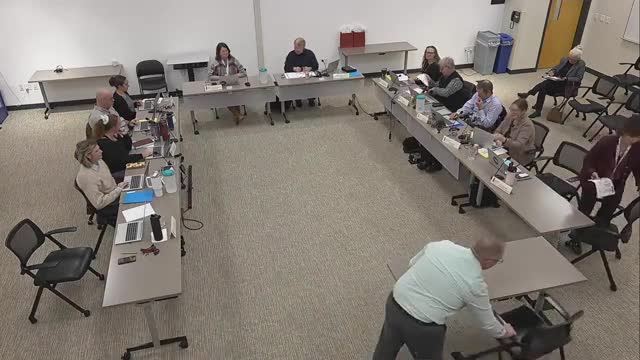MCPSD board hears detailed student assessment results, staff outlines next steps on curriculum and interventions
October 28, 2025 | Middleton-Cross Plains Area School District, School Districts, Wisconsin
This article was created by AI summarizing key points discussed. AI makes mistakes, so for full details and context, please refer to the video of the full meeting. Please report any errors so we can fix them. Report an error »

The Middleton-Cross Plains Area School District Board of Education heard a detailed report Oct. 27 on statewide student assessments, including Forward (grades 3–8 and grade 10 social studies), Dynamic Learning Maps (DLM) for students with alternative standards, the preACT for ninth- and tenth-graders, and the ACT for eleventh-graders. Assistant Superintendent Jan Chenoweth introduced the presentation and said staff would review metrics disaggregated by student group and race and noted small group suppression rules for groups under 20 students.
Marybeth Talis, director of elementary curriculum, instruction and assessment, told the board that district results remain generally above statewide averages across subject areas, and that most grade-level trend lines were stable or showed slight increases from last year to this year. She said the Forward exam data include four performance levels and that the district reports the percentage of students “at or above benchmark” (the top two categories).
Talis and Ken Metz, director of secondary curriculum, instruction and assessment, emphasized subgroup and cohort analyses. They reported gaps in achievement—particularly for Hispanic/Latino and Black students—and showed disaggregated math and English language arts results. Talis noted that multilingual learners are included only while they are actively in the program; students who have exited multilingual programming are not counted in that subgroup.
Board members asked several technical questions. Bartlett Duran asked about measuring growth rather than only proficiency; staff said they calculate student growth percentiles (growth from one assessment administration to the next compared with academically similar peers) and that the district is piloting analytics (including an AI-based tool) to examine trajectories for multilingual learners. Ken Metz confirmed staff will provide additional science data from the preACT/ACT upon request.
On the preACT and ACT, Metz reported district scores above state averages and that trend data across the past three years are generally stable or improving. He noted the ACT composite and subject composites, and he explained that the ACT writing score is a 12-point scale that is scaled to the 36-point composite for comparability.
Next steps presented to the board included continued curriculum renewal (math is in year one of renewal; CTE, world languages and performing arts are in other years of the cycle), expanded reading interventions (including districtwide pilots of reading intervention programs), continued SABIS implementation K–8, culturally responsive teaching and learning work, and a focus on specially designed instruction and progress monitoring for students on IEPs.
Board members requested additional breakdowns of score ranges within subgroups and more growth-curve analysis; staff agreed to provide further analyses and item-level reports where available. Several members praised the overall direction of the data while urging continued focus on closing achievement gaps.
Provenance: The assessment presentation began when assistant superintendent Jan Chenoweth introduced the topic and Marybeth Talis and Ken Metz presented assessment results (transcript blocks starting ~00:23:22) and concluded when presenters finished and the board moved to the next agenda item (~55:31).
Marybeth Talis, director of elementary curriculum, instruction and assessment, told the board that district results remain generally above statewide averages across subject areas, and that most grade-level trend lines were stable or showed slight increases from last year to this year. She said the Forward exam data include four performance levels and that the district reports the percentage of students “at or above benchmark” (the top two categories).
Talis and Ken Metz, director of secondary curriculum, instruction and assessment, emphasized subgroup and cohort analyses. They reported gaps in achievement—particularly for Hispanic/Latino and Black students—and showed disaggregated math and English language arts results. Talis noted that multilingual learners are included only while they are actively in the program; students who have exited multilingual programming are not counted in that subgroup.
Board members asked several technical questions. Bartlett Duran asked about measuring growth rather than only proficiency; staff said they calculate student growth percentiles (growth from one assessment administration to the next compared with academically similar peers) and that the district is piloting analytics (including an AI-based tool) to examine trajectories for multilingual learners. Ken Metz confirmed staff will provide additional science data from the preACT/ACT upon request.
On the preACT and ACT, Metz reported district scores above state averages and that trend data across the past three years are generally stable or improving. He noted the ACT composite and subject composites, and he explained that the ACT writing score is a 12-point scale that is scaled to the 36-point composite for comparability.
Next steps presented to the board included continued curriculum renewal (math is in year one of renewal; CTE, world languages and performing arts are in other years of the cycle), expanded reading interventions (including districtwide pilots of reading intervention programs), continued SABIS implementation K–8, culturally responsive teaching and learning work, and a focus on specially designed instruction and progress monitoring for students on IEPs.
Board members requested additional breakdowns of score ranges within subgroups and more growth-curve analysis; staff agreed to provide further analyses and item-level reports where available. Several members praised the overall direction of the data while urging continued focus on closing achievement gaps.
Provenance: The assessment presentation began when assistant superintendent Jan Chenoweth introduced the topic and Marybeth Talis and Ken Metz presented assessment results (transcript blocks starting ~00:23:22) and concluded when presenters finished and the board moved to the next agenda item (~55:31).
Don't Miss a Word: See the Full Meeting!
Go beyond summaries. Unlock every video, transcript, and key insight with a Founder Membership.
✓
Get instant access to full meeting videos
✓
Search and clip any phrase from complete transcripts
✓
Receive AI-powered summaries & custom alerts
✓
Enjoy lifetime, unrestricted access to government data
30-day money-back guarantee

